Designer | Everyday Design | Exhibitions and Shows | Fritz Hansen | Kartell | Knoll | Nils Holger Moormann | Producer | Product | smow | Thonet | Vitra
In the exhibtion A Chair and You at the Grassi Museum für Angewandte Kunst, Leipzig, there is more than A Chair and You can look at them, study them, explore them, converse with them. But not sit on them.
In the presentation Stühle zum (Be)Sitzen on the first floor landing of the Grassi Museum für Angewandte Kunst, Leipzig, there is more than A Chair and You can look at them, study them, explore them, converse with them. And sit on them.
Thirteen chairs which unite more than just thirteen definitions of 'A Chair', and more than just thirteen different seating experiences.....

Going straight to the gravy, yes, Stühle zum (Be)Sitzen is a smow showcase, there's a strong clue in the play on 'to sit' [sitzen] and 'to possess' [besitzen] of the title, that thing that a furniture store offers that a furniture museum doesn't, can't; the answer to that regularly posed question of how do you differentiate a furniture store from a furniture museum. And there is an even stronger clue in the smow Pop-up part of the title.
However despite being a smow presentation Stühle zum (Be)Sitzen is not the sort of guerilla showcase we used to undertake — ¡¡¡those were the days!!! — but is very much a part of the Grassi Museum für Angewandte Kunst's 150th anniversary celebrations, and also, in many regards, an accompaniment to A Chair And You, is an alternative, and much calmer, space in which to reflect on chairs, seats, sitting and sitters, a space to sit seated on a chair and expand and develop the thoughts began in A Chair and You. And also an alternative space outwith the Grassi Museum für Angewandte Kunst's permanent collection exhibition and its myriad chairs from throughout (hi)story, in which to undertake a brief tour through the recent (hi)story of chair design.
A brief tour through the recent (hi)story of chair design, or certainly western European chair design, that opens with Michael Thonet's 1859 Chair 14, the contemporary Thonet Chair 214, a.k.a the Vienna Coffee House chair, that work that not only greatly contributed to the development of chair design in the 19th century, took the decadence and opulence and ostentation of mid-19th century Viennese society and reduced it to a silhouette, ¿and in doing so also made a statement on the hollowness of, lack of substance within, the decadence and opulence and ostentation of mid-19th century Viennese society?, but a work that also redefined chair production: Thonet's warm bentwood process negating the need for skilled carpenters, relying instead on a workforce of highly trained but otherwise unskilled labour, and thereby, essentially, marking the dawn of industrialised furniture production. An introduction of a near industrialised production, and near industrialised output, that was to be central to Thonet establishing themselves as one of the first truly global furniture manufacturers.
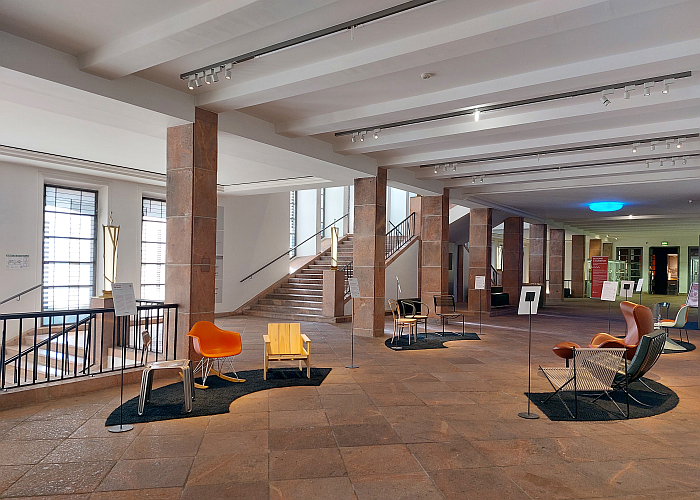
From the Thonet 214 the tour moves on to the Thonet 209 bentwood armchair from 1900, that flowing, curving, billowing work, that not only expands and rounds the Thonet 214 and thereby helps highlight the reduction and reserve of the 214, but in many regards exemplifies better than the 214 the possibilities inherent in Michael Thonet's use of a collection of standardised components to develop near infinite families of chairs, rather than having an artisan individually craft all components of a chair as part of a single production process; a pre-fabricated production process that while not entirely Michael Thonet's invention, was one he made his own. A Thonet 209 that being a work by the Thonet Design Team reminds not only of the importance of Thonet's Design Team to the development of Thonet and furniture design over the decades, but also stands tribute to the great many anonymous individuals who have contributed, and continue to contribute, to that development. The (hi)story of furniture design isn't one of 'Star' designers, but of team work.
And a Thonet 209 that Le Corbusier famously adored and used in many of his interiors, including the interiors of his houses at the 1927 Weissenhofsiedlung building exhibition in Stuttgart.
A 1927 building exhibition at which Mart Stam premiered his W1 and W2 the, by all accounts and as far as (hi)story has recorded, first cantilevered steel tube chairs and of which the Thonet S 33 that can be explored in Stühle zum (Be)Sitzen is a direct further development, not least in the fact it is not quite as rigid as the W1 and W2: not as formally rigid, is slightly softer, it curves a little more, than the uncompromisingly quadratic of the W1 and W2, and not as structurally rigid, is slightly softer, is more resilient in the sitting experience; a resilience that for all it is today a central feature of the cantilever chair wasn't at the forefront Stam's intentions with the W1 and W2, rather is a resilience which a Ludwig Mies van der Rohe brought to the cantilever, largely because he was extremely critical of, and unhappy with, Stam's design.
A Thonet S 33 and Thonet 209 that represent not only a highly informative co-existence of bent tubular wood and bent tubular steel in Functionalist Modernist visions of contemporary interiors in the late 1920s, a reminder that the (hi)story of furniture design isn't successive but is aggregative, cumulative, the new less ousting the exiting as joining the existing, adding to it, but also helping underscore Thonet's important role in driving furniture design and interior design in the early 20th century, and the question one thereby naturally poses as to how are Thonet contributing to furniture design and interior design in the early 21st century.
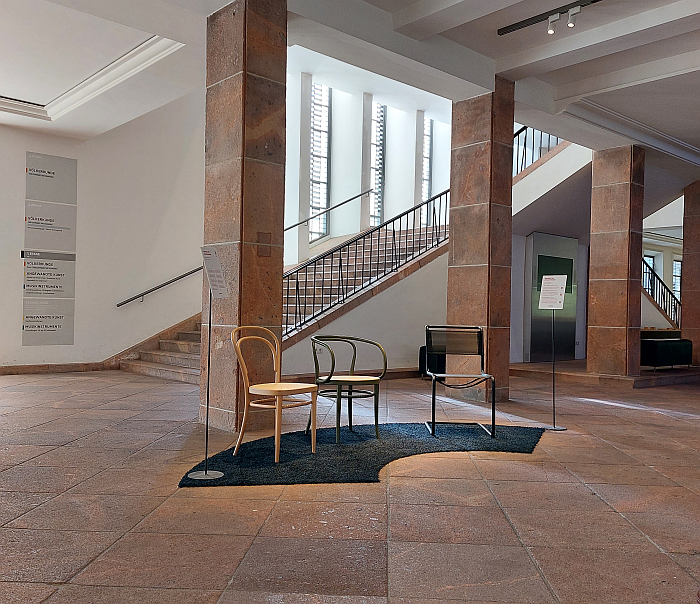
And a steel tube cantilever next to two bentwood chairs, an opportunity for a direct comparison, that helps elucidate how Michael Thonet's late 19th century bentwood, his late 19th century wood bending process, influenced and informed the aesthetics of furniture in the early 20th century; arguably enabled the rise of the reduced aesthetic that stands so oft proxy for the 1920s and 30s, empowered designers to realise an aesthetic for their furniture in keeping with their positions and in keeping with the social and economic realities of the period. If, certainly in the case of a Mart Stam, in a much more quadratic reduction that Michael Thonet's curving, flowing reduction.
A Thonet curving, flowing, billowing, organic, that can also be followed in the base of the 1929 Barcelona Chair by Ludwig Mies van der Rohe and Sergius Ruegenberg, the latter of whom famously, or not so famously, but which should be famously, shaped the seat, or at least began the process of shaping the seat, through sitting in the sand on a beach by way of approaching the required relationship between seat and backrest, albeit sat in the sand not on Barcelona Beach but on Wannsee Beach, on the southern edge of Berlin. And a work which for all it was first used as seating for the comfort and convenience of King Alfonso XIII and Queen consort Victoria of Spain during their brief visit to the German Pavilion at the 1929 Exposició Internacional de Barcelona, was an object driven by Mies van der Rohe's desire to have a representative seating object to use in his architectural projects, projects that for all they are often considered as quadratic as the chairs of Stam, or the cushions of the Barcelona Chair, regularly contain softer, curving elements, as with the Barcelona base. How many times he actually employed it in his architecture projects is unclear, it was present in the Berlin apartment of Mildred Crous from 1930, in the more or less contemporaneous Villa Tugendhat, Brno and almost certainly in Haus Lange, Krefeld, and was also employed in the scenography of Mies' contribution to the exhibition Die Wohnung unserer Zeit, The Apartment of our Age, at the 1931 Deutsches Bauausstellung in Berlin, otherwise evidence of its use is rare.
Unlike today where the Barcelona Chair is, inarguably, the archetype of the representative lobby chair, much as Mies van der Rohe intended it to be; but only exists as such because in the 1950s Florence Knoll was able to persuade Mies van der Rohe to allow Knoll to produce it.: Mies van der Rohe wasn't keen, was initially completely opposed to the idea, finally acquiesced. A reminder of the innumerable works of furniture design that we don't have today simply because there wasn't a manufacturer wanting to retail it. That inextricable link, the interdependency, between culture and commerce.
And, and deviating slightly from Stühle zum (Be)Sitzen and its brief tour, downstairs, next to the entrance to A Chair and You one finds Rudolf Horn's 1964 Conferstar chair, a work that arose because having sat on a Barcelona Chair, one notes in the Grassi Museum für Angewandte Kunst's, then, permanent collection exhibition, which is an outrageous thing to do, please don't do such, remember and respect the difference between a furniture store and a furniture museum....... but arguably is good that Horn did, for finding the Barcelona Chair uncomfortable beyond words, approving of the materials and aesthetics but disliking the experience of the Barcelona Chair almost as much Mies van der Rohe disliked everything about Stam's W1, Horn went back to his studio and redesigned the base to be more resilient and responsive, exactly that which Mies van der Rohe had once done to Stam's design. Which may or may not be ironic, we'd obviously have to ask Alanis Morissette. And then double check with Ed Byrne. And a comparison between the rigid Barcelona and the resilient Conferstar that one can undertake in the Grassi Museum für Angewandte Kunst, ¡¡¡outwith the permanent collection exhibition!!!, that is well worth making. As is understanding the changes Horn made to the base and following those changes into the differences in seating experience. And reflecting on what that can teach us about how we should approach accepted historic models, conventions and concepts.
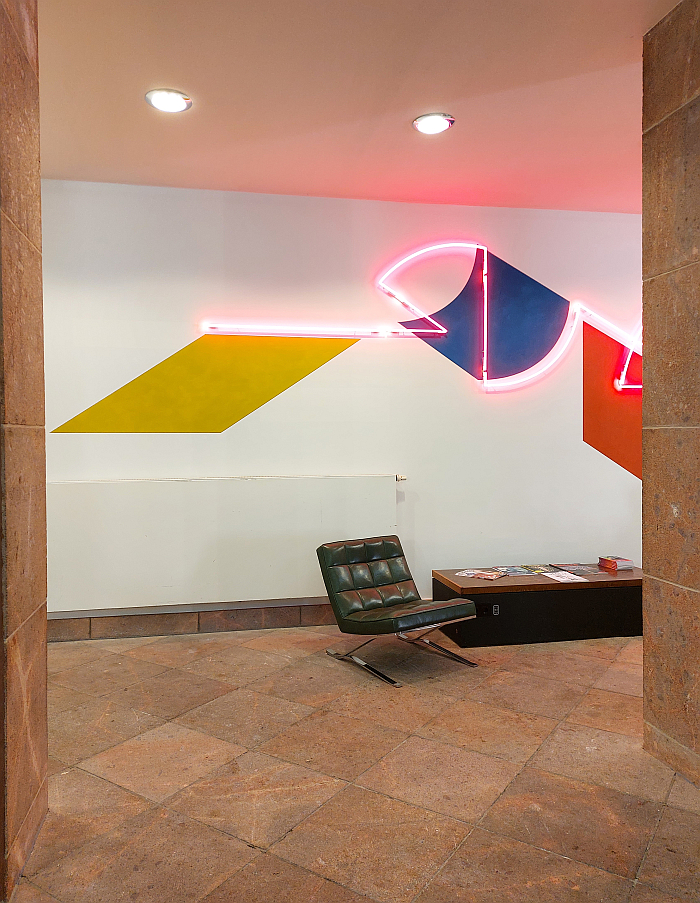
Formally not dissimilar to Mies van der Rohe and Ruegenberg's Barcelona Chair, if materially about as dissimilar as its possible to be, is Gerrit T. Rietveld's Crate Lounge Chair from 1934 in a re-edition through Hay, a re-edition that initially caused us a few problems, gave us a bit of stomach ache. Still does but much less than before. The cause of our irritation was our long held belief that the original Crate furniture was made from recycled wood, and thus the glaring discrepancy with Hay's version in new wood. Having looked a bit deeper, having actually read some books and journals rather than thinking we know things, and, yes, that is also a bit advice for contemporary society, we can't find any definite evidence that Rietveld ever used recycled wood, if unsubstantiated indications he may have. Possibly, but then again.......
Rather on our reading of the (hi)story of Rietveld's Crate furniture collection it appears much more that he was inspired by the construction, simplicity, beauty, reduction, material, pragmatism, et al of the wooden crates in which expensive furniture was shipped in the early 20th century, and questioning why consumers appreciated the finely carpented furniture within the crate but not the equally finely carpented crate, chose the latter over the former and developed a furniture collection, including a lounge chair, 'from' shipping crates. Yet whereas in contrast to a Louise Brigham who in the late 19th/early 20th century created furniture from actual redundant and discarded shipping crates, was a very real pioneer of recycling long before recycling was a real thing, Rietveld used new wood, as do Hay.
Whereby we wish they didn't. We wish Hay would, and it's not to late, take the opportunity inherent in a relaunch to use recycled wood, to complete Rietveld's thought process, to realise that which Rietveld was approaching in the 1930s but either couldn't see or couldn't reach. Or perhaps arguably even better, it would be more than appropriate and meaningful if Hay constructed Rietveld's Crate furniture from the Ophiostoma fungus infested spruce met in context of Alexander von Dombois's Beetlechair project; wood that normally doesn't get used in furniture because of the light blue tinge to the phloem caused by the fungi, but which as wood is as good, is as structurally sound, as uninfected wood, just has a light blue tinge. And thus a use of wood for furniture that currently isn't used for furniture that would not only represent a questioning of the wood for furniture that is also inherent in Rietveld's Crate collection, but would also be an extension, and carrying forward, of the questions of material sourcing and sustainability inherent in Rietveld's, and Brigham's, work into the 21st century and the realities of the global warming we've caused. It's recycling before the material has entered the system.
It's 21st century recycling. 21st century considerations on material realities and cycles.
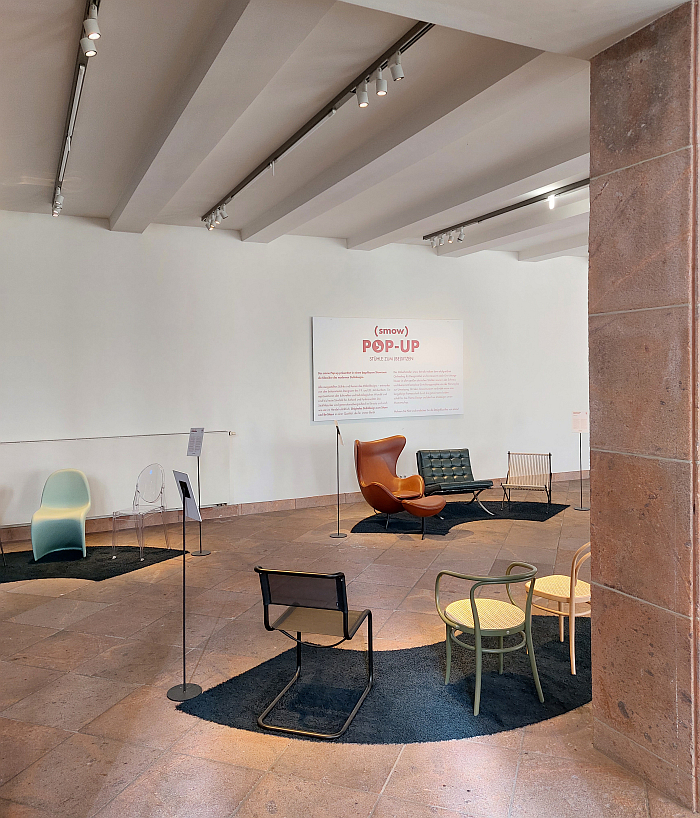
As is the synthetic plastic employed in the Eames RAR that stands, rocks, literally and physically, next to Rietveld's Crate Lounge Chair; a RAR, a member of an Eames' 1950 plastic shell chair family, whose (hi)story is also a succinct overview of the use of synthetic plastics in furniture: originally in fibreglass, at that time an achingly novel material, and, arguably, the first synthetic plastic to enable the production of durable furniture in synthetic plastics, before considerations on the ecological sustainability and impact of fibreglass saw production switch to polypropylene, which itself began to be increasingly questioned in context of its ecological sustainability and impact, questioning which saw Vitra switch production of the Eames plastic shells in 2024 to a novel synthetic plastic won from recycled waste.
And an Eames RAR that when premiered in context of the Museum of Modern Art, MoMA, New York's 1948 International Competition for Low-Cost Furniture Design featured a base composed, essentially, of two crossed metal tubes, a not unappealing and certainly well considered solution, but not the Eiffel Tower base that is so central to the agency of the object today. An Eiffel Tower base which, as previously noted in these dispatches, was developed in the early 1950s, more or less in context of the development of the Eames DKR wire chair, and which has defined the RAR since its formal commercial launch in 1953.
An Eames RAR that when viewed in such company as the aforementioned, and the still to be mentioned, allows one to appreciate how Charles and Ray contributed to advancing furniture design in terms of materials, form, use, and the relationships that can exist between furniture and user and furniture and space; and which also neatly elucidates how the Eames helped advance the industrialisation of furniture design and production through an interchangeability of parts, took up that principle which had been so successful for Thonet and used contemporary technology to make it a furniture industry standard.
And an Eames RAR that opens what is the most represented decade in Stühle zum (Be)Sitzen, which may tell us all something about the importance of the 1950s in and for furniture design in western Europe, or tell us all something about the perspective of those who made the selection. Which wasn't us, we're rarely there when decisions are made, our function is much more commenting on them after the fact. Whereby, yes, you're right, we could be there when decisions are made, but invariably are in a museum or library. Where we're much happier than we are in offices and meetings.
A 1950s that having opened with the Eames moves on to Poul Kjærholm's PK 4 though Fritz Hansen, a work that is amongst the earliest of Kjærholm's chair designs and thus represents some of Kjærholm's earliest positions on and to chairs, furniture, interiors and design; and a work in steel tube and halyard developed from Kjærholm's graduation project at Copenhagen's School of Arts and Crafts, the so-called Element chair, the contemporary Fritz Hansen PK 25, a work in spring steel and halyard that helps underscore that for all the prominence of wood in furniture design from Denmark in the 1950s, other materials were being employed. If not so often, arguably on account of the lack of industry in 1950s Denmark to produce goods in materials other than wood.
And a PK 4 that is primarily a simplifying of Kjærholm's Element chair to enable it to be mass produced for 1950s Denmark, if that is someone could be found who could mass produce a work in steel tube and halyard. Which initially wasn't the case; the first PK 4 frames were made by blacksmith Svend Holscher with Poul and his wife Hanne tying the halyard by hand at home, which we suppose is furniture production à la a Jørgen Roos' "time-honoured tradition and quality craftsmanship", if not how Roos meant it. Or in a context that is helpful in the marketing of furniture from Denmark. That job cabinet makers perform so effortlessly. Stereotypically almost.
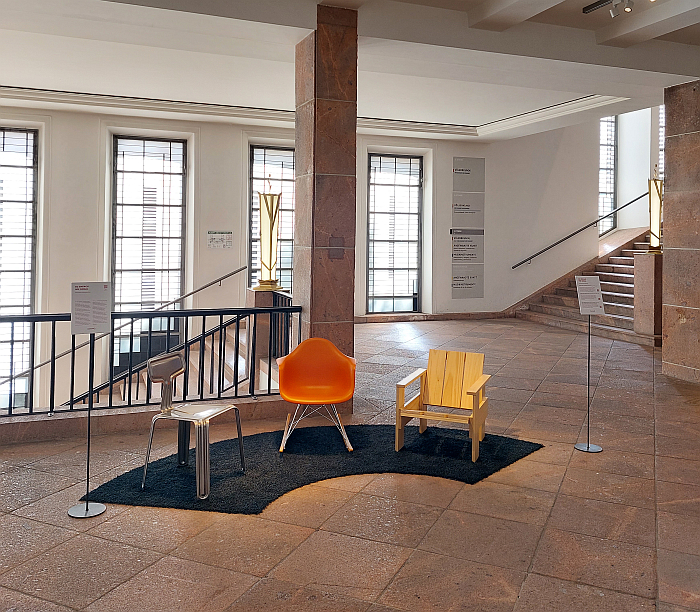
And an attempt to develop affordable, mass producible, furniture for a mass public in 1950s Denmark, an attempt to develop furniture appropriate for and responsive to the realities of 1950s Denmark, that can also be understood in the 1955 Series 7 by Arne Jacobsen.
A work Jacobsen developed from the three-legged 1952 Ant chair, essentially, because Fritz Hansen wanted a four-legged side chair and Arne Jacobsen didn't want a four-legged Ant, and in many regards is that work which best typifies the move observable in context of the exhibition Arne Jacobsen – Designing Denmark at Trapholt, Kolding, in Jacobsen's oeuvre away from project specific designs which could become consumer products but weren't intended as consumer products, such as the Ant, to works designed for an anonymous mass public, such as Series 7; an indication of Jacobsen's increasing understanding after the 1939-1945 War of design as a component of wider society, of design as a service for society. And thus a Series 7 that is not just Jacobsen's best selling chair design, but a key milestone in Jacobsen's career. A rare correlation between sales and relevance. Although, see also the Chair 14.
And a Series 7 that we once opined, and still maintain, is the basis for Jacobsen's 1958 Egg lounge chair: the Egg being, in our argument, an inflated version of Jacobsen's Series 7, is a Series 7 to which Jacobsen has attached an air pump, as if it were a balloon, and inflated it to an Egg, or least a hemisphere of an Egg. Or perhaps staying in context of Stühle zum (Be)Sitzen, Jacobsen Popped-up his Series 7 to an Egg.
An opinion, a claim, that the inclusion of both an Egg and a Series 7 in Stühle zum (Be)Sitzen allows you to reflect on, particularly satisfyingly so as it is a fully upholstered Series 7. Thus as you stand, or sit, in front of the Series 7 and the Egg you can expand the former in your mind and watch it grow into the latter. And as you do, to agree with us.
Now all we have to do is prove that is what Jacobsen actually did.
A 1950s Denmark that also saw the origins of considerations on the possibility of a chair that it would be 1967 before it was realised and 1968 before it became a series product: Verner Panton's eponymous chair through Vitra. A Panton Chair that, arguably, couldn't have been realised in the Denmark of that period, regardless of the symbolism of Jacobsen's SAS Royal hotel, required Verner Panton to look outwith Denmark for a partner; a Panton Chair that took the cantilever of a Stam's S 33 and its contemporaries and not only translated it from steel tubing into polyurethane, thereby helping confirm the durability of synthetic plastics, but also rounded the Cubist corners of the Functionalist Modernist steel tube furniture of the 1920s as 30s, and thereby not only began to find a way back to the flowing curves of a Michael Thonet, but also created a piece of furniture more attune with the less formal, less rigid, less austere, less quadratic, somewhat freer, mellower, organic, western European society of the 1970s.
A path away from the positions and contexts embodied by a Stam's S 33 that can also be followed in the 1971 Typ 3300 by Bruno Rey, a work originally through Dietiker, that Swiss manufacturer who, not least through the influence of and cooperations with Willy Guhl, that so important and informative Swiss furniture designer, and under whom Bruno Rey studied, played such an key role in the development of furniture design and the furniture industry in Switzerland in the second half of the 20th century, reissued through Hay, in cooperation with Dietiker, as the Rey Chair.
A Rey Chair that not only visually continues the path back to the Thonet 14, place them next to each other, explore, but also continues the path forward from the Thonet 14 in its novel use of technology to enable a new construction principle for furniture: the core of the Rey Chair is an aluminium bracket developed by Rey and Dietiker that enables a screw-less metal-to-wood connection and a seat that 'floats' between the legs, a novel form of seat construction, a chair without a frame, arguably the first representative of that genre, that not only bequeaths the Rey Chair its visual lightness, nor only allows it to stand as a questioning of what the 'Post' in 'Postmodern' means, but also allows it to be used in a variety of scenarios.
Facts that, arguably, greatly contributed to the Typ 3300 becoming the best selling Swiss chair, ever. No mean feat when one considers the many other notable pretenders to that crown.
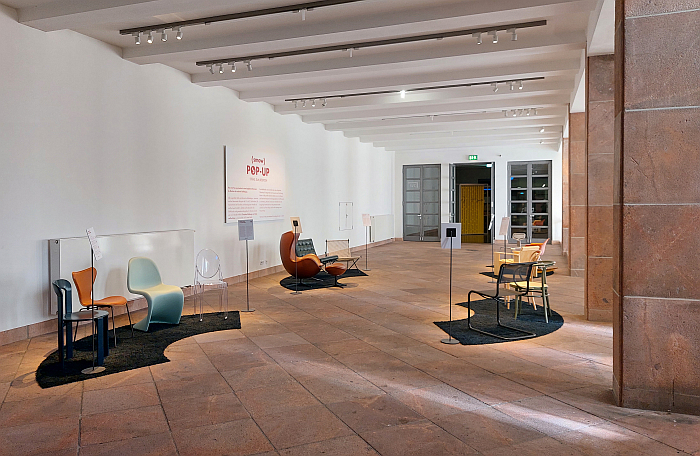
Much as the abundance of 1950s furniture, and designers of Danish birth, may or may not be informative of either the (hi)story of furniture design in western Europe and/or those smow colleagues who made the selection, so the complete lack of furniture from the 1980s and 1990s to be found in Stühle zum (Be)Sitzen. Very complicated, challenging decades in context of furniture design, decades that tend to provoke and polarise rather than inviting you for a cosy get-together, a sumptuous meal or to relax and unwind, and decades (very) well represented, for very good reasons, in A Chair and You. And an absence of the 1980s and 1990s in Stühle zum (Be)Sitzen that is a demand you investigate yourself what could, should, ¿must?, have stood there. How would you expand Stühle zum (Be)Sitzen?
If a tour through the (hi)story of chair design in western Europe that after the 1970s picks up its narrative again in 2005 with the Victoria Ghost through Kartell, a work by a designer who very much made a name for himself, established his positions, and argued passionately and resolutely for those positions, in the 1980s and 1990s: Philippe Starck, that almost too good epitome of the confidence, brashness, decadence, provocation, vivacité, of design in 1980s and 1990s France, of the desire in 1980s and 1990s France to forcibly, conclusively, break with the past, as the citizens of France so often have.
A Victoria Ghost that traces its origins back to 1998 and Starck's La Marie for Kartell, the world's first completely transparent chair, a transparency, an immateriality that is also possessed, albeit through a different conceit, by Kjærholm's PK 4, if that is you can possess an immateriality.... but certainly a PK4 that allows for wider considerations on transparency in furniture design, on the visual weight of furniture and the myriad ways furniture contribute to and influence space. And a La Marie from which Starck and Kartell developed a family of works employing the visuals and symbolism of the furniture of the past in transparent synthetic plastics, including Victoria Ghost with its classic medallion backrest ¿And thereby questioning the emptiness of the past styles, the emptiness of our fascination with maintaining that which once was, much as a Michael Thonet may possibly once have critically reflected on the decadence and opulence and ostentation of mid-19th century Viennese society in a chair design?
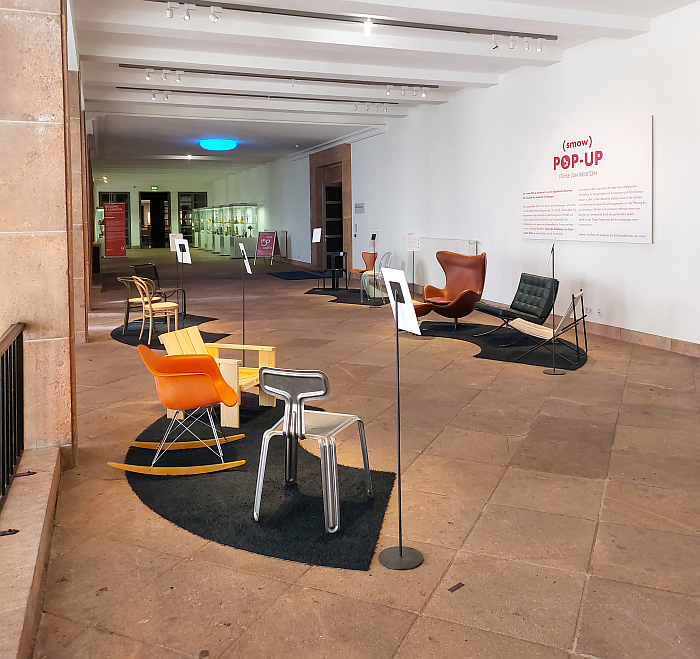
Stühle zum (Be)Sitzen's brief tour through the (hi)story of chair design in western Europe ends with Harry Thaler's 2011 Pressed Chair through Nils Holger Moormann, a chair that as Harry once told us began as "a small fork made from one piece of wood", became a desire to create a chair in one material, and which through the choice of pressed aluminium not only neatly translates the moulded plywood of, for example, Arne Jacobsen, Aino and Alvar Aalto or Charles and Ray Eames into metal, but reminds that the plastic shell of the RAR that rocks next to the Pressed Chair in Stühle zum (Be)Sitzen began life as pressed steel, before that was deemed too expensive and the, then, novel fibreglass was used.
And also reminds of the moulded aluminium chair Gerrit T. Rietveld developed in the early 1940s, and that from similar motivations to Harry, but which Rietveld didn't entirely manage to create from a single sheet of aluminium, much as didn't manage to recycle shipping crates. Which doesn't mean Rietveld is design's Nearly Man, far from it, rather indicates how innovative he was in his thinking but that society and technology weren't at a stage to make those thoughts tangible: it would take the development of the concept of recycling to allow the Crate Chair to reach its destination, ¡¡¡Come on Hay, you know you want to!!!, and the development of novel technology, and novel aluminium, and novel appreciations on our use of materials, and novel appreciations of relationships with furniture, among other novelties, to enable Harry Thaler's Pressed Chair.
And thus also a reminder, one of numerous reminders in Stühle zum (Be)Sitzen, that the (hi)story of furniture design isn't linear but is a helix that continually comes back to where it once was just in new contexts and with new materials, technology, possibilities, understandings and perspectives. And always comes back with lessons that can be learned. If we are wise enough to.
¡¡¡Come on Hay, you know you want to!!!
And a Pressed Chair produced by Nils Holger Moormann, a manufacturer, a furniture publishing house, who arose from the ferment of 1980s Neue Deutsche Design, that questioning, challenging, provoking and polarising of and with furniture design and relationships to furniture of that period, by the eponymous Nils Holger Moormann who as a designer took the impulses and experiences of Neue Deutsche Design and began developing furniture that for all it appears very far removed from the brashness, insolence, humour, questioning, challenging, provoking and polarising of the 1980s, is but an alterative expression of that brashness, insolence, humour, questioning, challenging, provoking and polarising. Is very often Neue Deutsche Design in an age far removed from that which (em)powered Neue Deutsche Design, is a Neue Deutsche Design response to an age far removed from that which (em)powered Neue Deutsche Design. Something that can be appreciated downstairs, next to the ticket desk and the Grassi Shop, in the form of Nils' 2007 Bookinist armchair and chariot, a further diversion from Stühle zum (Be)Sitzen that it is well worth taking.
Much as Stühle zum (Be)Sitzen is a diversion well worth taking from the Grassi Museum für Angewandte Kunst's permanent collection exhibition and from A Chair and You.
And, no, we're not just saying that. That ain't our style.
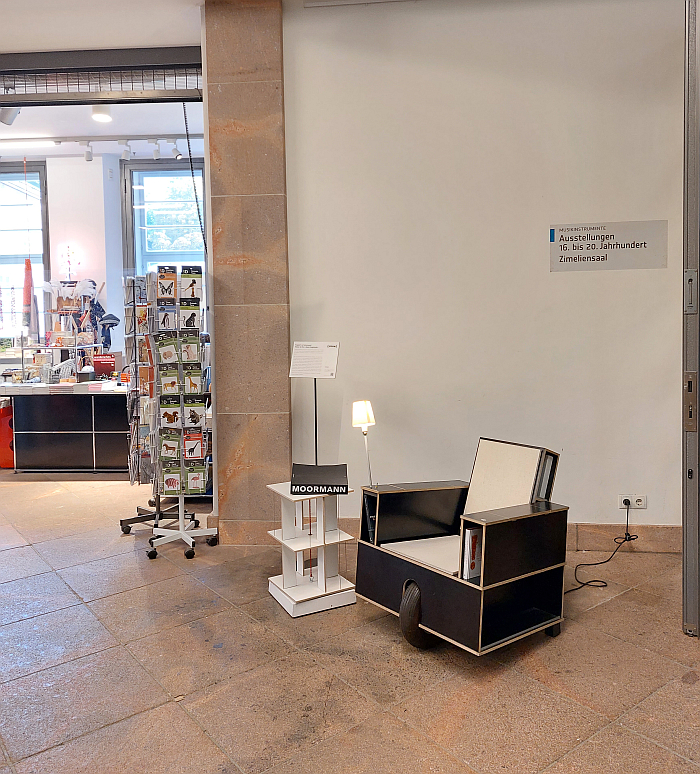
But because you have to sit on chairs to appreciate the sitting comfort and security. Which brings us back to Rudolf Horn. A Rudolf Horn who may also be the reason the Barcelona Chair in the Grassi Museum's permanent collection exhibition is on a revolving platform.
For as Horn's experience with the Barcelona Chair underscores, a chair may appeal to you aesthetically, may speak to you in terms of materials, forms, proportions, etc, but if it doesn't offer the seating experience you require and demand, it's not A Chair for You, and you can only gauge the possibilities for a relationship between A Chair and You through sitting on it. Which, yes, is one of the problems of online furniture retailing, and why it makes perfect sense to combine the advantages of online and offline retailing in one holistic, responsive, experience.
And also one of the problems of furniture museums and exhibitions.
For all that furniture museums' permanent collection exhibitions can allow one to better appreciate not only the developments furniture has made over the centuries, and the contexts in which those developments occurred, and how the developments in furniture relate to developments elsewhere in our goods of daily use and cultural expression, factors that can be effortlessly followed in the Grassi's permanent collection exhibition, they don't allow any appreciation as to if a chair is actually comfortable, is something you want to use. Neither does Instagram.
In addition, and staying with museum permanent collection exhibitions and Instagram, the lack of interaction tends to advance a purely visual appreciation of furniture, tends to reinforce appreciations of furniture as being about visuals and not functionality, usability, relationships with the contemporary society from which they arose, the relationships that can develop with furniture etc, etc.
An understanding of furniture, of chairs, as being more than visuals elegantly elucidated in A Chair and You; a presentation of works whose function is often more metaphysical than physical, theoretical rather than practical, didactic rather than... whatever the antonym of didactic is. It's not what they look like that's important, but what they embody, represent and mediate. As is the case with those chairs whose primary function is physical, practical and without didactic intent.
And an understanding of furniture, of chairs, of chairs intended to be sat on, chairs one must sit on, as being more than visuals ably supported by Stühle zum (Be)Sitzen.
Only 3 of the 13 featured in Stühle zum (Be)Sitzen can be found the Grassi's permanent collection exhibition, or could be found the day we visited, and that a long way from one another, yet as Stühle zum (Be)Sitzen allows one to better appreciate, understanding the (hi)story of chair design, understanding chairs as more than objects to be looked at and sat on, understanding chairs as components of an ongoing journey through relationships between individuals, societies and their objects of daily use, understanding chairs as moments in the technological, material, cultural, economic, political, et al developments of any society, requires studying, exploring, conversing with, sitting on, more than A Chair in isolation but with a group of chairs together, in context of and in open dialogue with one another.
That thing a furniture store allows you to do.
Or can allow you to do once you stop viewing chairs as commercial goods and start viewing them as cultural goods, as moments on the journey we are all on. A realigning of your perspective on chairs that for all a furniture store may appear an odd, counter-intuitive, place to begin, can often be the best place.
It's all a question of the furniture store you view chairs in and discuss chairs with.
Choose wisely.
Stühle zum (Be)Sitzen can be viewed, sat on, enjoyed, engaged with, criticised, on the first floor landing of the Grassi Museum für Angewandte Kunst, Johannisplatz 5–11, 04103 Leipzig.
And it's free.